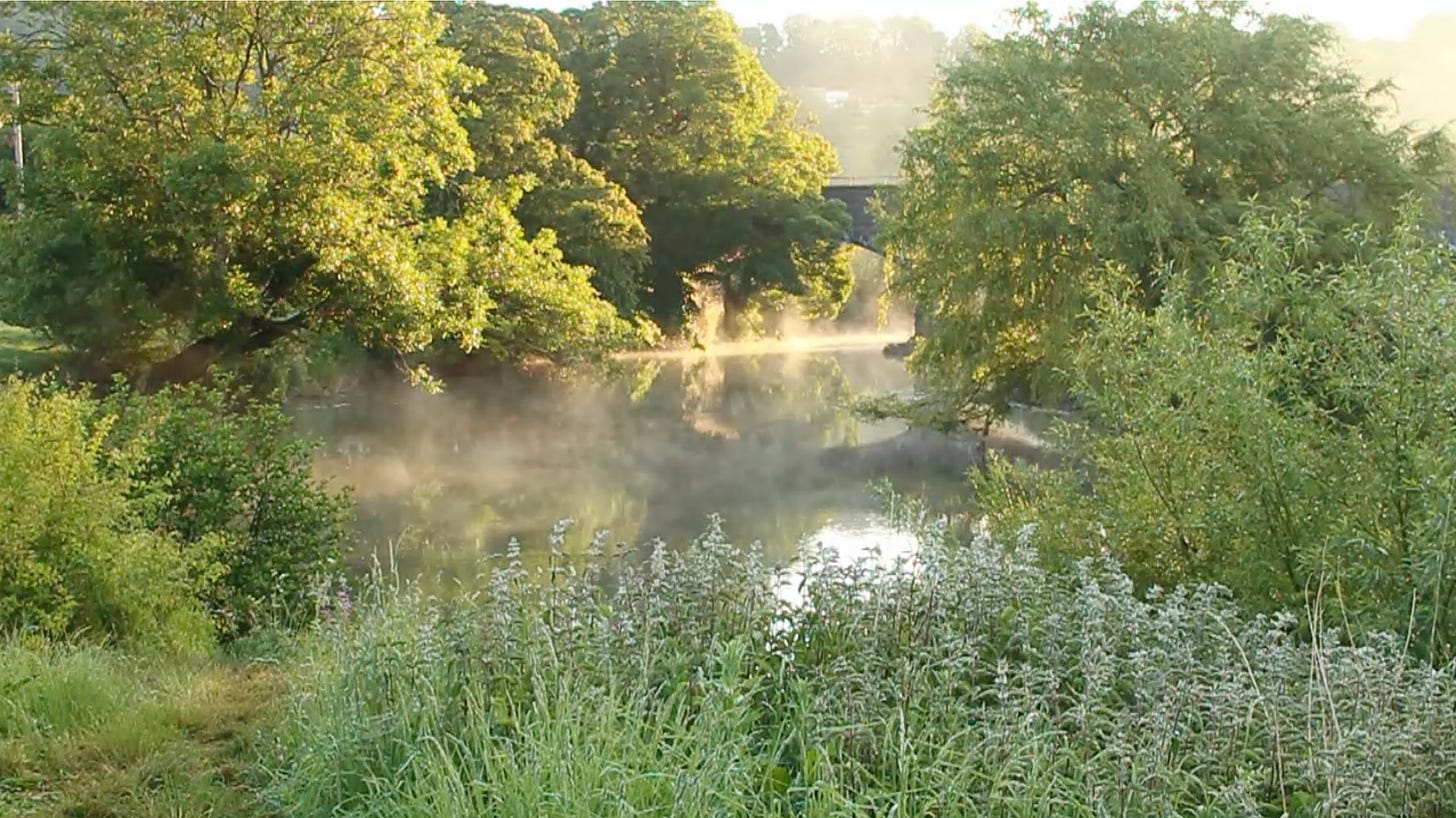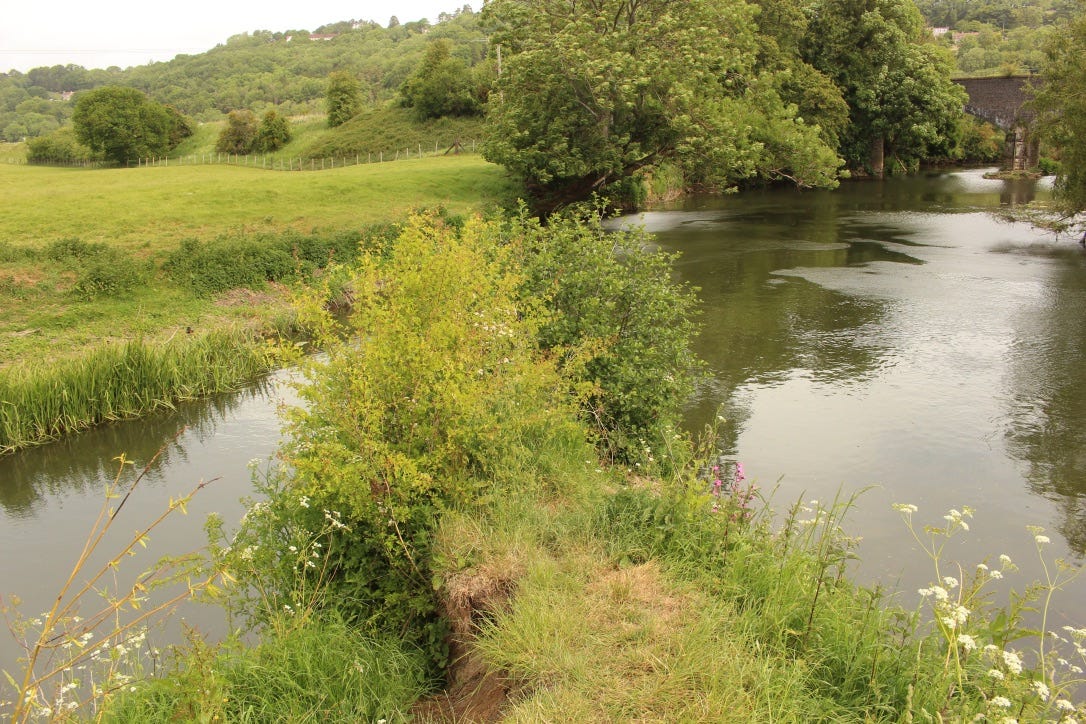Startled by Kingfisher
I wrote these notes some while ago, but this story of an encounter last summer has not appeared on Learning How Land Speaks. I had not visited River for quite while after staying out on midsummer night and getting very cold. I feel I have neglected my companion. This place that I have visited so often seems homely, familiar, welcoming, right from the moment I get out of the car. As I walk across the field and approach the spot where I sit, I feel I am visiting an old friend.
Once I arrive, I notice how much the vegetation has grown up: the little willow tree on the stump next to my spot must be twice as high as when I first started to come here; the alder at the end of the peninsular much bushier. In addition, at the height of summer, everything is leafed up and so my vision is much more contained.
I greet and bow to River as usual, offer tea and flapjack. I tell River (and myself) I am not here to offer ceremony or to ask for teaching, I am simply here to re-establish contact, to sit and be with. I settle close to the water’s edge, keeping my mind free of chatter while I gaze openly, taking in everything I can see and hear. I watch the water flowing past, listen to the wrens, see a pair flying so quickly from branch to branch in the willow tree, as if playing. A mallard seems content to sit in the middle of River, dabbling for weed. Cows come down on the opposite bank to drink. Kingfishers fly upstream and downstream, skimming the surface as they go about their business. For a while I can see where one is fishing from the occasional splashes in the water. I am pleased to see them again.
Then suddenly, Kingfisher arrives, flying low upstream close to the bank, passing within a yard of my feet hanging over the bank, swooping up into the willow tree, circling around, plunging down again, and wheeling off upstream out of sight. As ki1 passes close to me, I am caught by the characteristic whirring flight, then as ki rises in the tree the sun catches the feathers in a brilliant turquoise against the green leaves. Amazing, beautiful, special.
At first, I assume that this was simply a sighting of a kingfisher along with all the others – rather special indeed, but just another sighting. I have been learning to distinguish between kingfishers going about their kingfisher business and Kingfisher in ontopoetic response to my invocation – for example when kin have appeared close after ceremony. But at first, this appearance doesn’t seem like this.
But back home, I find myself wondering: could this encounter more truly be seen as an ontopoetic gesture, a response to my attentive presence? For this was such unusual behaviour: I usually see Kingfisher flying low and fast across the water surface, or if I am lucky catch a glimpse of them perching above the water and diving for fish. Even though this appearance did not occur in direct response to my call, could it be a gesture of greeting, an acknowledgement of my presence after some absence? And how would I know? Or maybe I never can know for certain.
I wonder if I am making too much of this event, which only took a few seconds, fearing that I may be projecting my desire for a living response onto a simple fly-past. And yet, it may well be that these simple gestures actually occur much more frequently than the Western mind allows, and that my re-education in living in a sentient world will lead me to see such gestures more frequently.
I send a copy of my account and my wondering to my panpsychic fellow inquirers. This in the spirit of co-operative inquiry, extending my own reflections to engage with my human companions. David and Luisa both tell me to simply enjoy the beauty of the experience and not analyse it too much. Fair enough, but I still want to understand more.
Then Dave writes
This was no simple fly-past. I don’t think you’re making too much of it. Doesn’t all identification with another have to be rooted in imagination? For reasons mysterious, when I enter vision quest mind the world seems changed and I find I am seeing with new eyes. Then unusual sights and sounds and feelings happen. Ontopoetic happenings are all around us all the time since we live in a mind-filled world. But it’s also true also that almost all the time I tune the miracles out. Like you, my Western mind is hungry for re-education: longing to belong in a sentient world. It makes me happy to read about your Kingfisher and it encourages me to make time to open the doors of perception more often in the hope of seeing with new eyes.
Freya writes
To me your kingfisher moment seems like a quintessential ontopoetic response! Your visit to River, your attentive frame of mind, your inner address, all constitute the invocation.
Sandra writes
I too feel that it is intentional and communicative. I recognise what you mean when you refer to seeing with new eyes. I also notice that the act of singing out or calling up River or Ngangungadditj Waugul (river spirit – a beautiful rainbow, sparkly river snake) changes me and brings me to my senses (That old English saying had wisdom!). I then notice more, perceive and experience more. Kimberley Indigenous people call this Liyan, and place has Liyan too. Relying upon Liyan, people will set out on a long walk knowing Country will care for them on their walk. (Country with capitals is a broad sense of the word, inclusive of spirit and relationships.) Using Liyan, they trust that it will guide them around dangers.2
Later, reading Freya’s reflections on contemporary animism, in which view the world is full of persons, only some of which are human, I come across this:
‘…we as humans may forget the complex cross-species negotiation that lies at the heart culture, other species do not forget. As soon as we start to observe the protocols again — by engaging in ceremonial forms of exchange with the wider community of persons, for example — those persons immediately respond, by turning up at our rituals or offering other ‘signs’ of their attention’
And as Tioikasin Ghosthorse tells us
No matter what language you speak, a hidden, nurturing world is already at work with you.3
As botanist and Potawatomi plant woman Robin Wall Kimmerer has pointed out, how we refer to sentient beings matters: to use the pronoun ‘it’ is not only odd and disrespectful, it objectifies. Yet standard English offers no alternative. Kimmerer suggests we draw on the Potawatomi word Aakibmaadiziiwin, which means ‘a being of the earth.’ She asks, ‘might we hear a new pronoun at the beginning of the word, from the ‘aaki’ part that means land? Ki to signify a being of the living earth. Not he or she, but ki.’ Following Kimmerer’s prompt, in this writing, rather than ‘it’, I am using ‘ki’ singular and ‘kin’ plural. I also capitalise the names of beings with whom I am in particular relation. See Kimmerer, Robin Wall. "Speaking of Nature: Finding Language That Affirms Our Kinship with the Natural World." Orion March/April (2017).
For a description of Liyan from Indigenous Australian elder Paddy Roe, see Mathews, Freya. The Dao of Civilization: A Letter to China. London and New York: Anthem Press, 2023, p.57
Ghosthorse, Tiokasin. "Nurturing Thoughts." In Kinship: Belonging in a World of Relationships, edited by Gavin van Horn, Robin Wall Kimmerer, and John Hausdoerffer, vol 05 Practice, 82-89. Libertyville, Ill: Centre for Humans and Nature, 2021.




A wonderful article that brings together much of what I have been reading on this site, over the last 6 months. What does Dave mean by, ‘vision quest mind’? I don’t know that I have seen this in any of the other articles or responses.
“it may well be that these simple gestures actually occur much more frequently than the Western mind allows, and that my re-education in living in a sentient world will lead me to see such gestures more frequently.” May it be so! 🙏